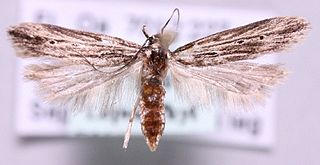
Monochroa is a genus of moths in the family Gelechiidae.

Monochroa lucidella is a moth of the family Gelechiidae. It is found in most of Europe, except Spain, Switzerland and most of the Balkan Peninsula. It is recorded from the Near East and Siberia (Transbaikalia).

Monochroa cytisella is a moth of the family Gelechiidae and found in most of Europe. The larva feed in the stems of bracken causing a slight gall.

Bryotropha boreella is a moth of the family Gelechiidae. It has a disjunct alpine-boreal distribution. It is locally common in central and northern Europe, northern England and Scotland. In Scandinavia, it is found in north-western Denmark, Sweden and Finland. It is also present in the French Alps, Germany and Austria. Records from the Ural need confirmation.
Monochroa suffusella, the notch wing neb, is a moth of the family Gelechiidae. It is found from Fennoscandia to the Pyrenees and Alps and from Ireland to Romania. In the east, the range extends to Japan. The habitat consists of bogs, fens, swamps and salt-marshes.

Caryocolum kroesmanniella is a moth of the family Gelechiidae. It is found from Fennoscandia to the Pyrenees, Alps and Romania and from Great Britain to southern Russia. The habitat consists of open woodland.
Monochroa uralensis is a moth of the family Gelechiidae. It is found in Russia. The habitat consists of dry steppes close to moist meadows.
Metanarsia modesta is a moth of the family Gelechiidae. It is found in southern Italy, Romania, Ukraine, Turkey, Armenia, north-eastern Iran, Iraq, Turkmenistan, Uzbekistan, Russia, and south-eastern and northern Kazakhstan. The habitat consists of steppes.
Metanarsia incertella is a moth of the family Gelechiidae. It is found in Spain, Algeria, Morocco, Tunisia, Turkey, Russia, Kazakhstan, Uzbekistan, western China and Mongolia.

Monochroa conspersella is a moth of the family Gelechiidae. In Europe, it is found from the Alps to the north. In the east, the range extends to the southern Ural and the Middle Volga, as well as Japan.

Monochroa tetragonella, the saltern neb, is a moth of the family Gelechiidae. It is found in Scandinavia, the Baltic region, Great Britain, the Netherlands and Russia. The habitat consists of saltmarshes.

Monochroa elongella, the Pembroke neb, is a moth of the family Gelechiidae. It is widely distributed throughout Europe. Outside of Europe, it is found in southern Siberia. The habitat consists of coastal sand-dunes and chalk downland.

Monochroa lutulentella, the black neb, is a moth of the family Gelechiidae. It is widely distributed in northern Europe and the central European mountains, east to the Ural Mountains. The habitat consists of fens, marshes and on river-banks.

Monochroa divisella, the scarce marsh neb, is a moth of the family Gelechiidae. It is found in Denmark, Latvia, Germany, the Netherlands, Belgium, Great Britain, the Czech Republic, Hungary, Bulgaria and France. Outside of Europe, it is known from Korea, the Russian Far East and Japan. The habitat consists of fens, marshes, river-banks and other damp areas.

Monochroa palustrellus, the wainscot neb, is a moth of the family Gelechiidae. It is found in from western, central and northern Europe to the Ural Mountains and southern Siberia. The habitat consists of waste ground, dry pastures and sand-dunes.
Monochroa nomadella is a moth of the family Gelechiidae. It is found from southern and central Europe to the southern Ural. It is also found in Mongolia. Records of M. nomadella from France and north-western Italy refer to Monochroa bronzella. The species prefers calcareous habitats.

Monochroa rumicetella is a moth of the family Gelechiidae. It was described by O. Hofmann in 1868. It is found from Fennoscandia and Belarus to Portugal, the Alps and Greece, and from France to Romania.

Monochroa tenebrella, the common plain neb, is a moth of the family Gelechiidae. It was described by Jacob Hübner in 1817. It is found in most of Europe. The habitat consists of open grassy areas and heathland.
Monochroa discriminata is a moth of the family Gelechiidae. It was described by Edward Meyrick in 1923. It is found in North America, where it has been recorded from southern Ontario.
Monochroa sperata is a moth of the family Gelechiidae. It was described by Peter Huemer and Ole Karsholt in 2010. It is found in the south-western Alps of France and Italy.











